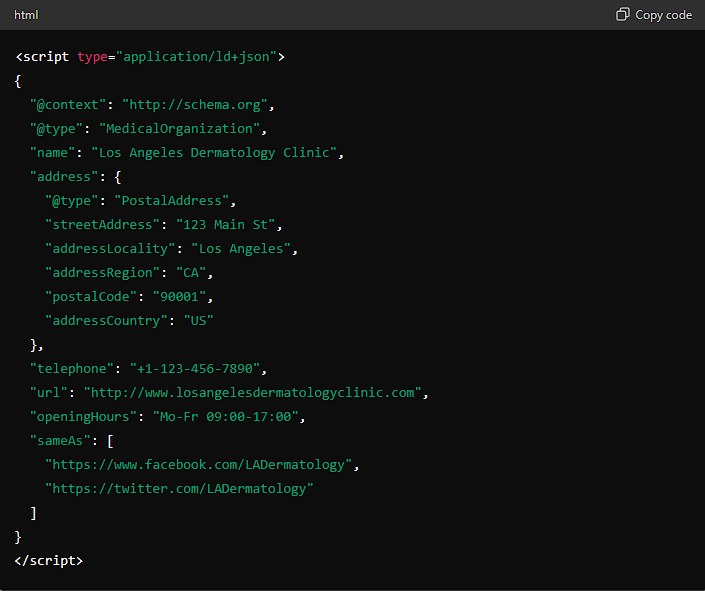This Article has been revised, edited and added to, by Poulomi Chakraborty.
- Understanding NAP Citations: The Basics
- Building and Maintaining Accurate NAP Citations
- The Role of Google My Business in NAP Citations
- Leveraging Local Directories and Citations for Enhanced Local SEO
- The Impact of NAP Citations on Patient Trust and Engagement
- Building Patient Trust Through Consistent Information
- Enhancing Patient Engagement with Accurate Citations
- Facilitating Smooth Patient Experience
- Leveraging Reviews to Complement NAP Citations
- Integrating NAP Citations into Your Marketing Strategy
- Using Social Media to Support NAP Consistency
- Monitoring Patient Feedback and Adjusting NAP Information
- Continuous Improvement and Adaptation
- The Role of Schema Markup in Enhancing NAP Citations
- Conclusion
In the digital age, having a strong online presence is crucial for healthcare providers. When potential patients search for healthcare services, they often look for providers in their local area. This is where local SEO comes into play. One of the most important elements of local SEO is ensuring that your NAP citations—name, address, and phone number—are consistent across the internet. NAP citations help search engines verify your business information, improving your visibility in local search results. This article will delve into the importance of NAP citations for local healthcare SEO, providing detailed insights and actionable strategies to enhance your online presence.
Understanding NAP Citations: The Basics

NAP citations refer to the mention of your business’s name, address, and phone number on various online platforms. These citations can be found on directories, websites, social media profiles, and other online locations.
Consistent and accurate NAP citations are essential for local SEO because they help search engines confirm the legitimacy of your business and improve your ranking in local search results.
Comparison: NAP Citations vs. Traditional SEO
To understand the importance of NAP citations, it’s helpful to compare them with traditional SEO. Traditional SEO focuses on optimizing your website to rank higher in search engine results pages (SERPs) through the use of keywords, high-quality content, and backlinks.
While these elements are critical for driving organic traffic to your site, they do not specifically target local search queries.
NAP citations, on the other hand, are a fundamental aspect of local SEO. They help your business appear in local search results when potential patients search for services in their area.
For example, when someone searches for “pediatrician near me,” search engines look for NAP citations to determine which businesses are relevant and trustworthy in that specific location. Accurate and consistent NAP citations can significantly boost your visibility in local search results, driving more traffic to your practice.
Why NAP Citations Matter for Healthcare Providers
For healthcare providers, local SEO is especially important because patients typically look for services close to home or work. NAP citations ensure that your practice appears in local search results, making it easier for potential patients to find and contact you. Inconsistent or incorrect NAP citations can confuse search engines and patients alike, leading to lower search rankings and missed opportunities.
Accurate NAP citations also build trust with potential patients. When your business information is consistent across all platforms, it signals to patients that your practice is reliable and professional. This trust is crucial in the healthcare industry, where patients need to feel confident in their choice of provider.
Key Elements of Effective NAP Citations
Several key elements contribute to effective NAP citations. These include accuracy, consistency, and completeness. Each element plays a crucial role in ensuring that your practice’s information is easily accessible and trustworthy.
Accuracy
The accuracy of your NAP information is paramount. Any discrepancies, such as a misspelled name or incorrect phone number, can undermine your local SEO efforts. Ensure that your practice’s name, address, and phone number are correct on all platforms. Even minor errors can confuse search engines and potential patients.
Consistency
Consistency is equally important. Your NAP information should be identical across all online platforms, including your website, Google My Business profile, social media profiles, and online directories. Inconsistent information can lead to lower search rankings because search engines may struggle to verify your business’s legitimacy.
Completeness
Completeness involves providing all necessary information. In addition to your name, address, and phone number, include other relevant details such as your website URL, hours of operation, and services offered. Complete information helps search engines understand your business better and improves your chances of appearing in local search results.
Comparison: NAP Citations vs. Backlinks
While both NAP citations and backlinks are important for SEO, they serve different purposes. Backlinks, or inbound links, are links from other websites to your own. They are a signal to search engines that your content is valuable and trustworthy, which can improve your overall search rankings.
NAP citations, however, are specifically focused on local SEO. They help search engines verify your business’s location and contact information, making them crucial for appearing in local search results. Unlike backlinks, which can come from a variety of sources, NAP citations are typically found on directories, social media profiles, and other local platforms.
Building and Maintaining Accurate NAP Citations

Building and maintaining accurate NAP citations is crucial for enhancing your local SEO. Here’s how to ensure that your practice’s name, address, and phone number are consistent across the internet, improving your chances of appearing in local search results.
Conducting a NAP Audit
The first step in ensuring accurate NAP citations is to conduct a thorough audit. This involves listing all the places where your practice’s information appears online, including your website, Google My Business profile, social media profiles, and various online directories. Check each platform for accuracy and consistency.
During the audit, note any discrepancies, such as variations in the spelling of your practice’s name or differences in the format of your address. For example, “123 Main St.” should not appear as “123 Main Street” or “123 Main St, Suite 100” on different platforms. Consistent formatting helps search engines recognize and validate your business information.
Correcting Inconsistencies
After identifying discrepancies in your NAP information, the next step is to correct them. Update your details on each platform to ensure they match exactly. This may involve logging into each directory or profile and manually editing the information.
For instance, if your practice’s phone number appears as “(123) 456-7890” on your website but “123-456-7890” on your Google My Business profile, choose one format and apply it universally. Consistency in every detail helps search engines recognize and validate your business information, improving your local SEO.
Using Data Aggregators
Data aggregators can simplify the process of maintaining accurate NAP citations. These services distribute your business information to various online directories and platforms, ensuring consistency across the internet. Using a data aggregator can save time and effort, as it automates the process of updating your details.
Popular data aggregators include Yext, Moz Local, and BrightLocal. These tools help you manage your online presence more efficiently, ensuring that your NAP information remains accurate and consistent everywhere it appears.
Regular reports from these tools can also provide insights into your local search performance and highlight areas for improvement.
Leveraging Citation Management Tools
Citation management tools like Whitespark and SEMrush can help you track and manage your NAP citations. These tools scan the web for your business information, identify inaccuracies, and update your details across various platforms.
Regularly using these tools helps you maintain accurate and consistent NAP information, enhancing your local SEO efforts.
These tools also provide valuable insights into your local search performance. By regularly reviewing these insights, you can identify areas for improvement and ensure that your practice maintains a strong and trustworthy online presence. This proactive approach helps you stay ahead of potential issues and keeps your NAP information up-to-date.
Ensuring Consistent NAP Information on Your Website
Your website is often the first place potential patients go to find information about your practice. Ensuring that your NAP information is accurate and consistent on your website is crucial. Include your practice’s name, address, and phone number on your homepage, contact page, and footer.
Consider using schema markup to provide additional context for search engines. Schema markup is a type of microdata that helps search engines understand the content of your website. By adding schema markup to your NAP information, you can improve your local SEO and increase your chances of appearing in local search results.
Updating NAP Information Promptly
If your practice undergoes any changes, such as moving to a new location, adding a new branch, or changing your phone number, update your NAP information immediately across all platforms. Delays in updating this information can lead to confusion and missed opportunities, as potential patients might encounter outdated details.
For example, if your practice relocates, update your address on your website, Google My Business profile, social media profiles, and all online directories as soon as possible. This ensures that search engines and potential patients have access to the most accurate and current information.
Monitoring and Maintaining NAP Consistency
Maintaining accurate NAP information is an ongoing task. Set up a schedule to periodically review your business details across all platforms, especially after making any changes to your practice’s name, address, or phone number. Regular audits help catch and correct any inaccuracies promptly.
Monitoring tools can help you track your NAP information and identify discrepancies. Google Alerts can notify you when your practice is mentioned online, allowing you to track new citations and respond accordingly. Regular monitoring ensures that your NAP information remains accurate and consistent, enhancing your local SEO efforts.
The Role of Google My Business in NAP Citations

Google My Business (GMB) is a critical platform for healthcare providers aiming to enhance their local SEO through accurate NAP citations. An optimized GMB profile can significantly improve your visibility in local search results and provide potential patients with essential information about your practice.
Setting Up and Verifying Your Google My Business Profile
The first step to leveraging Google My Business is to set up and verify your profile. Visit the Google My Business website, sign in with your Google account, and search for your practice.
If it appears in the search results, claim it and follow the prompts to verify ownership. If it doesn’t appear, you can add it manually by providing your business name, address, and contact information.
Verification usually involves receiving a postcard from Google with a verification code that you’ll enter into your GMB account. This process is crucial as it confirms to Google that you are the rightful owner of the business, allowing you to manage your profile and update information.
Providing Accurate Business Information
Once your GMB profile is verified, fill out your profile with accurate and comprehensive information. Ensure that your practice’s name, address, and phone number are correct and consistent with other online platforms. Include additional details such as your website URL, hours of operation, and services offered.
Accuracy in this information is essential for improving your local SEO. Consistent NAP details across your GMB profile, website, and other directories help search engines verify your business and improve your rankings in local search results.
Utilizing GMB Features for Enhanced Visibility
Google My Business offers several features that can enhance your profile’s visibility and engagement, making it easier for potential patients to find and contact you.
Google My Business Posts
GMB Posts allow you to share updates, news, and special offers directly on your profile. For healthcare providers, this feature can be used to announce new services, provide health tips, or share updates about your practice. Regularly updating your posts keeps your profile dynamic and engaging.
When creating posts, keep them concise and informative. Include a call to action, such as “Schedule an Appointment” or “Learn More,” to encourage interaction. These posts not only provide useful information but also show that your practice is active and responsive to patient needs.
Photos and Videos
Adding high-quality photos and videos to your GMB profile can significantly enhance its appeal. Visual content helps potential patients get a sense of your practice and the services you offer. Include photos of the exterior and interior of your office, staff members, and any special equipment or amenities.
Videos can be particularly engaging. Consider creating short videos that introduce your team, showcase your facilities, or highlight patient testimonials. These videos make your profile more dynamic and help build trust with potential patients.
Q&A Section
The Questions and Answers section allows potential patients to ask questions directly on your GMB profile. Actively managing this section by providing prompt and accurate responses can enhance your profile’s usefulness and demonstrate your commitment to patient care.
Encourage your staff to monitor this section regularly and respond to questions as they arise. Providing detailed and informative answers can help potential patients make informed decisions and reduce the number of phone calls to your office with common inquiries.
Managing Reviews on Google My Business
Patient reviews are a critical component of your GMB profile. Positive reviews can enhance your reputation and attract more patients, while responding to reviews demonstrates your commitment to patient care.
Encourage satisfied patients to leave positive reviews by providing direct links to your GMB profile and asking for feedback after appointments. Responding to reviews, both positive and negative, shows that you value patient input and are committed to improving their experience.
Using GMB Insights to Improve Local SEO
Google My Business provides valuable insights into how patients are interacting with your profile. These insights include data on how many people viewed your profile, how they found it, and what actions they took, such as visiting your website or requesting directions.
Use these insights to gauge the effectiveness of your GMB optimization efforts and identify areas for improvement. For example, if you notice a high number of profile views but low engagement, consider updating your business description or adding more compelling photos and posts. Regularly reviewing and acting on these insights can help you continually improve your local SEO performance.
Ensuring NAP Consistency Across Platforms
Maintaining consistent NAP information across all platforms is crucial for local SEO. Your GMB profile should reflect the same details as your website, social media profiles, and other online directories. Inconsistent information can confuse search engines and potential patients, negatively impacting your search rankings.
Regularly audit your NAP information across all platforms to ensure accuracy and consistency. Use citation management tools to streamline this process and keep your information up-to-date. Consistent NAP details build trust with both search engines and potential patients, enhancing your local SEO efforts.

Leveraging Local Directories and Citations for Enhanced Local SEO
Beyond Google My Business, local directories and citations play a significant role in boosting your local SEO. These citations help search engines validate your business information, improving your visibility in local search results and making it easier for potential patients to find your practice.
The Importance of Local Directories
Local directories are online platforms that list businesses in specific geographic areas. For healthcare providers, being listed in relevant local directories can significantly enhance your local SEO.
These directories not only provide valuable backlinks to your website but also ensure that your NAP information is widely available and consistent across the internet.
For instance, directories like Healthgrades, Zocdoc, and Vitals are commonly used by patients searching for healthcare services. Being listed on these platforms ensures that your practice appears in search results when potential patients look for providers in your area.
Building and Managing Local Citations
Local citations are mentions of your NAP information on various websites, including local blogs, news sites, and industry-specific platforms. Building and maintaining accurate citations can improve your practice’s online presence and authority, which in turn boosts your local SEO.
Creating Citations
Start by identifying relevant local directories and platforms where you can list your practice. This includes both general business directories like Yelp and industry-specific directories like Healthgrades. Ensure that your NAP information is accurate and consistent across all these platforms.
Additionally, seek opportunities to be mentioned in local publications and directories. This could involve contributing articles to local health blogs, being featured in local news stories, or participating in community events and getting listed on event websites. Each mention of your NAP information on a credible site acts as a citation that strengthens your local SEO.
Ensuring Accuracy and Consistency
The accuracy and consistency of your NAP information across all citations are crucial. Inaccurate or inconsistent citations can confuse search engines and potential patients, leading to lower search rankings and missed opportunities. Regularly audit your citations to verify their accuracy and make corrections as needed.
If you find incorrect citations, contact the site owner or webmaster to request updates. Provide them with your correct NAP information to streamline the process. Consistent and accurate citations reinforce your practice’s credibility and improve your chances of ranking higher in local search results.
Utilizing Citation Management Tools
Managing citations manually can be time-consuming, especially for larger practices with multiple locations. Citation management tools like Moz Local, Yext, and BrightLocal can help streamline the process.
These tools automatically scan the web for your NAP information, identify inaccuracies, and update your details across various platforms.
Using these tools ensures that your citations remain accurate and up-to-date, enhancing your local SEO efforts. Regular reports from citation management tools can also provide insights into your local search performance and highlight areas for improvement.
Leveraging Local SEO for Multi-Location Practices
For healthcare providers with multiple locations, managing NAP citations and local SEO can be more complex. Each location needs its own accurate and consistent NAP information to ensure that search engines can verify and rank each practice location correctly.
Create individual Google My Business profiles for each location, ensuring that each profile is fully optimized with accurate NAP information, detailed business descriptions, and high-quality photos. Similarly, ensure that each location is listed in relevant local directories and that citations are accurate for each address.
Monitoring and Maintaining Citations
Regularly monitoring and maintaining your citations is essential for ongoing local SEO success. Set up a schedule to review your business details across all platforms, especially after making any changes to your practice’s name, address, or phone number. Regular audits help catch and correct any inaccuracies promptly.
Monitoring tools can help you track your NAP information and identify discrepancies. Google Alerts can notify you when your practice is mentioned online, allowing you to track new citations and respond accordingly. Regular monitoring ensures that your NAP information remains accurate and consistent, enhancing your local SEO efforts.
Addressing Common Citation Issues
Common issues with citations include outdated information, duplicate listings, and inconsistent details. Address these issues promptly to ensure that your NAP information is accurate and consistent across all platforms.
For outdated information, update your details on the relevant platforms. For duplicate listings, contact the platform to request consolidation or removal of the duplicate entries. For inconsistent details, ensure that your NAP information matches exactly across all platforms.
The Impact of NAP Citations on Patient Trust and Engagement

NAP citations not only play a crucial role in local SEO but also significantly impact patient trust and engagement. Accurate and consistent NAP information helps build credibility and ensures that patients can easily find and contact your practice.
Building Patient Trust Through Consistent Information
Patients rely on accurate information to make informed decisions about their healthcare. When your NAP information is consistent across all online platforms, it reassures potential patients that your practice is professional and trustworthy. Inconsistent or incorrect information can lead to confusion, frustration, and a lack of trust.
Imagine a potential patient looking for a new family doctor. They find your practice listed on multiple directories, but each one has different contact information. This inconsistency can make the patient question the reliability of your practice and potentially look elsewhere for care. Consistent NAP citations eliminate this doubt, making it easier for patients to trust your practice.
Enhancing Patient Engagement with Accurate Citations
Accurate NAP citations also enhance patient engagement by making it easier for patients to find and interact with your practice. When your contact information is readily available and consistent, patients are more likely to reach out for appointments, inquiries, or more information about your services.
For example, a potential patient searching for a dermatologist might find your practice on Google My Business, see your consistent NAP information, and immediately feel confident in calling to schedule an appointment. On the other hand, if they encounter conflicting phone numbers or addresses, they might hesitate or choose a different provider.
Facilitating Smooth Patient Experience
A smooth and hassle-free experience starts with accurate information. When patients can easily find your address and phone number, it reduces the friction in their journey to accessing your services. This ease of access is particularly important in healthcare, where patients often seek prompt and reliable care.
Consider a scenario where a patient needs to find your clinic quickly for an urgent appointment. Accurate and consistent NAP citations across online platforms ensure that they can find your location without confusion or delays. This seamless experience not only enhances patient satisfaction but also increases the likelihood of repeat visits and positive reviews.
Leveraging Reviews to Complement NAP Citations
Patient reviews complement NAP citations by providing social proof and enhancing your practice’s credibility. Positive reviews can boost your local SEO and attract more patients, while responding to reviews demonstrates your commitment to patient care.
Encourage satisfied patients to leave reviews on platforms where your NAP information is listed, such as Google My Business, Healthgrades, and Yelp. Positive reviews that appear alongside accurate NAP citations reinforce the reliability and professionalism of your practice, making it more appealing to potential patients.
Integrating NAP Citations into Your Marketing Strategy
Integrating NAP citations into your overall marketing strategy can amplify your efforts and enhance your local SEO. Ensure that your NAP information is prominently displayed on all marketing materials, including your website, social media profiles, email newsletters, and print advertisements.
For example, include your practice’s name, address, and phone number in the footer of your website and in the contact section of your email newsletters. This consistency reinforces your brand and ensures that patients always have access to accurate information.
Using Social Media to Support NAP Consistency
Social media platforms are another valuable avenue for ensuring NAP consistency. Make sure that your practice’s contact information is accurate and up-to-date on all social media profiles, including Facebook, Twitter, and Instagram. Consistent NAP information across social media platforms supports your local SEO efforts and makes it easier for patients to contact you.
Regularly update your social media profiles with accurate NAP details, especially if there are any changes to your practice’s name, address, or phone number. This proactive approach ensures that your information remains consistent and reliable across all online platforms.
Monitoring Patient Feedback and Adjusting NAP Information
Patient feedback can provide valuable insights into how well your NAP citations are working. Pay attention to any comments or reviews that mention difficulties in finding your practice or contacting you. Use this feedback to identify any inconsistencies or inaccuracies in your NAP information and make necessary adjustments.
For example, if multiple patients mention that they had trouble finding your clinic due to incorrect address information online, investigate and update your NAP details across all platforms. This responsiveness not only improves patient satisfaction but also enhances your practice’s online reputation.
Continuous Improvement and Adaptation
Maintaining accurate and consistent NAP citations is an ongoing process that requires continuous improvement and adaptation. Regularly audit your NAP information, update it promptly when changes occur, and monitor patient feedback to ensure that your practice’s contact details remain accurate and reliable.
By committing to ongoing NAP citation management, you can enhance your local SEO, build patient trust, and improve overall patient engagement. This proactive approach ensures that your practice remains visible, credible, and easily accessible to potential patients.
The Role of Schema Markup in Enhancing NAP Citations

Schema markup is a form of microdata that helps search engines understand the context of your content. For healthcare providers, implementing schema markup can enhance NAP citations, improve local SEO, and make your practice more visible in search results.
Understanding Schema Markup
Schema markup, or structured data, is code added to your website that provides additional information to search engines about the content on your site. This information helps search engines index your content more effectively and display rich snippets in search results, which can include details like your practice’s name, address, and phone number.
For healthcare providers, schema markup can include specific details such as the type of healthcare service you provide, the areas you serve, and additional contact information. Implementing schema markup can make your practice’s information more accessible and easier to find for both search engines and potential patients.
Implementing Local Business Schema
Local business schema is a type of schema markup specifically designed for businesses with a physical location. By adding local business schema to your website, you can provide search engines with detailed information about your practice, improving your local SEO.
To implement local business schema, add the appropriate structured data to your website’s HTML code. This includes your practice’s name, address, phone number, business hours, and any other relevant information. Several online tools and plugins can help generate the necessary code, making it easier to implement schema markup on your site.
For example, a dermatology clinic in Los Angeles might include local business schema that looks like this:

Enhancing NAP Citations with Schema Markup
Adding schema markup to your NAP citations can enhance their effectiveness and improve your local SEO. This structured data helps search engines accurately index your NAP information and display it in search results, making it easier for potential patients to find your practice.
For example, if a potential patient searches for “pediatrician near me,” having schema markup on your website can increase the chances of your practice appearing in the local pack or as a rich snippet. This visibility can drive more traffic to your site and improve patient engagement.
Monitoring the Effectiveness of Schema Markup
After implementing schema markup, it’s important to monitor its effectiveness. Use tools like Google Search Console to track how your schema markup is performing and to identify any issues. Google Search Console provides reports on structured data, showing how many pages contain valid markup and highlighting any errors that need to be addressed.
Regularly review these reports to ensure that your schema markup is functioning correctly and improving your local SEO. Address any issues promptly to maintain the accuracy and effectiveness of your structured data.
Combining Schema Markup with Other SEO Strategies
Schema markup should be part of a broader SEO strategy that includes accurate NAP citations, quality content, and strong backlinks. Combining these elements can enhance your local SEO and improve your practice’s visibility in search results.
For example, regularly updating your website with high-quality content that includes relevant local keywords can complement your schema markup efforts. Quality content provides value to potential patients and helps search engines understand the relevance of your practice.
Benefits of Schema Markup for Patient Engagement
Implementing schema markup can also enhance patient engagement by providing rich snippets in search results. Rich snippets can include additional information such as your practice’s location, contact details, and business hours, making it easier for patients to find and contact you.
For instance, a rich snippet for a dental clinic might display the clinic’s address, phone number, and business hours directly in the search results. This information provides a convenient and quick reference for potential patients, improving their experience and increasing the likelihood of engagement.
Staying Updated with Schema Markup Best Practices
Schema markup and structured data are continually evolving. Staying updated with the latest best practices and guidelines is essential to ensure that your schema markup remains effective. Regularly review resources such as Schema.org and Google’s Structured Data Guidelines to stay informed about any changes or updates.
Continuously improving and adapting your schema markup strategy ensures that your NAP citations and local SEO efforts remain effective and up-to-date. This proactive approach can help your practice maintain a strong online presence and attract more patients.
Conclusion
NAP citations are essential for local healthcare SEO, ensuring that your practice’s name, address, and phone number are accurate and consistent across all platforms. This consistency helps search engines validate your business information, improving your visibility in local search results and making it easier for potential patients to find and contact you.
Incorporating schema markup can further enhance your NAP citations, providing additional context for search engines and increasing your chances of appearing in local search results. By maintaining accurate NAP information, leveraging local directories, managing patient reviews, and implementing schema markup, you can build trust with potential patients and improve your practice’s online presence. These efforts, though ongoing, are crucial for standing out in a competitive local market and ensuring your healthcare practice continues to grow and thrive.
READ NEXT:





















